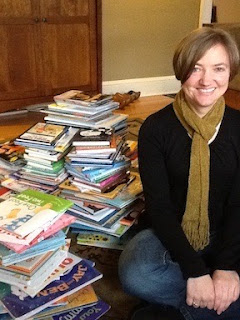 |
| Image courtesy of Amy Laughlin |
It’s likely that I’m the only librarian who attended New York’s Comic Con this year to scout for Geisel-eligible comics and graphic novels (was anyone else there also asking editors about emergent readers like I was? Show yourself!).
Did I see a plethora of amazing comics? Yes. Did I meet many incredibly talented #ownvoices comics creators and artists? You betcha. Did I walk away thinking, “I’m looking at a book that could absolutely be a Geisel winner/honor title!”?
Well, not exactly.
What I did leave thinking was this: there is an astounding quantity of extraordinary comics and graphic novels being published right now for young readers. Of those, a small number target emergent readers. An even smaller number of those rise above when specifically considering the Geisel criteria.
At every comic booth I visited I would pepper the staff with questions, including, “What’s the youngest reader you target with your comics?” Editors are listening to librarians and educators, and many are making a concerted effort to create original content aimed squarely at our youngest readers. Testimony to that is the fact that Geisel has already given honors and medals to a number of exceptional comics/graphic novels.
One comics publisher that has created Geisel medal and honor books already is TOON Books. This year, their book A Trip to the Top of the Volcano with Mouse by Frank Viva serves as a sequel/companion novel to 2012’s A Trip to the Bottom of the World with Mouse, and could certainly be a Geisel contender. Bright, punchy colors and a simple paneled layout help guide young readers along, though a few tricky words (“conduit,” for one) may be tough for some readers.
 |
| Could there be a Geisel coming for Mouse? Image from toon-books.com. |
Another comics publisher striving to create works specifically for young readers is Lion Forge. Founded in 2011, Lion Forge has #WeNeedDiverseBooks embedded in their identity, as founders David Steward II and Carl Reed are deeply committed to publishing “titles that reflect the diversity of the world in the characters, the creators, and the Lion Forge team.” Their imprint, Cubhouse, aimed at introducing children 8 and under to the world of comics, has an impressive roster of books aimed at the youngest comics and graphic novel enthusiasts.
Oni Press is yet another notable comics publisher to keep an eye on. Having published Katie O’Neill’s Eisner Award-winning Tea Dragon Society (based on her webcomic of the same name) in 2017, it’s easy to consider that Oni could have some Geisel contenders in the works. It’s worth noting that Oni Press and Lion Forge merged earlier this year, and time will tell how the merger will impact future published works.
 |
| Tea Dragon Festival, the 2019 follow up to Tea Dragon Society Image from onipress.com |
Two other comic giants to keep on the radar are Dark Horse Comics and the KABOOM! imprint from BOOM! Studios. Most of their current offerings are aimed at young elementary and would not necessarily be considered crossover titles that are suitable for Geisel readers—but that could change. Dark Horse and KABOOM! are ones to watch.
 |
| Could this KABOOM! comic/graphic novel be a Geisel? The look and feel of it are perfect for an emergent reader, but sadly it’s too long (at 208 pages). Image from i1.wp.com |
























